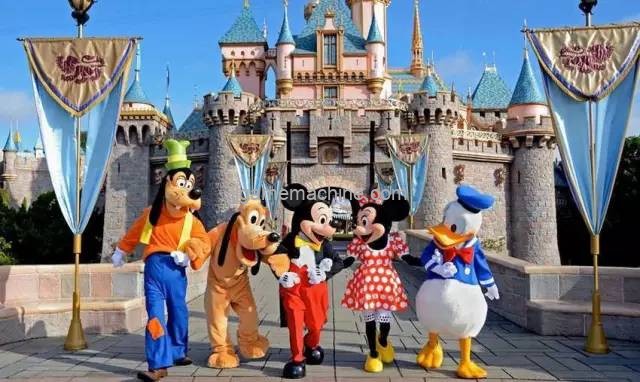Under the combined effect of the natural environment and economic and social factors, tourism consumption has a large time volatility, resulting in a significant time change and periodicity of tourist traffic in various scenic spots including theme parks. This feature of tourist flow is one of the most important reasons for the loss of most theme parks in China. Theme park decision makers must try to deal with it.

1. Performance, causes and negative impacts of the time change of tourist flow in theme parks
The temporal change of tourist traffic in theme parks is mainly manifested in three aspects: one is the interannual change of tourist traffic, the main reason is that like other types of tourist destinations, the theme park has a life cycle; the second is the tourist traffic within one year Seasonal differences, monthly differences, intra-month differences, differences between workdays and weekends, the main reason for this difference is cyclical factors such as climate change, vacation system; three is the difference in the number of tourists in the park at different times within a business day, it It is mainly caused by factors such as the spatial distance between the tourists and the theme park, the time required for the whole journey of the theme park, and the group composition of tourists.
For both the host and guest of the theme park, the time change of passenger flow has a positive impact. For example, the off-season provides park managers with the opportunity to prepare for the peak season, but also provides employees with the opportunity to take a rest, and saves tourists from waiting in line Time to play. However, if the time change of the passenger flow in the theme park is more drastic, the negative impact of the time change of the passenger flow on the park and tourists is often much greater than the positive impact. This negative impact includes at least the following aspects:
First of all, when the tourist flow is at a peak and obviously exceeds the reception capacity of the theme park, tourists will suffer from long queues, noisy environment, inconvenient food and accommodation due to overloading of the park. This will reduce the effective play time of tourists, reduce the quality of tourists' travel experience, affect their satisfaction with theme parks, revisit rate and word-of-mouth communication, and thus threaten the future market attractiveness, market competitiveness and economic benefits of theme parks.
Secondly, when the theme park is severely overloaded for a long period of time, the park's ticket sellers, waiters, actors and other staff generally have problems such as increased work errors, poor service attitudes, and unresponsive service response due to mental stress and physical fatigue. Various hardware facilities including amusement facilities may fail due to continuous operation, overload, and untimely maintenance.These software and hardware problems will also affect the tourist experience and satisfaction of tourists, and more seriously, they may induce security accidents and host-guest disputes, thereby endangering the personal safety of tourists and staff and the public image of theme parks.
Thirdly, the idle facilities and personnel in the tourist trough period will weaken the theme park's profitability and extend its investment recovery period. Theme parks are labor-intensive and investment-intensive industries, and the daily labor costs and fixed costs are high. Under the background that most theme parks in China still rely on ticket revenue as the main source of profit, if the daily passenger flow is much lower than the reception capacity of the theme park, the operating income of the theme park on that day is usually lower than the total cost. If the proportion of this situation is high in a year, theme parks are prone to suffer annual losses.
Finally, when insufficient tourist traffic occurs frequently or lasts for a long time, for the sake of cost reduction and other considerations, theme parks usually reduce the incentive income of employees, or even only pay basic salaries, while reducing or even canceling performance activities and closing parts Recreation facilities , these measures will dampen the enthusiasm of employees, increase employee turnover rate, and arouse dissatisfaction of tourists, which is very unfavorable for the long-term development of the theme park, and the life cycle of the theme park may be shortened.

2. Strategies for theme parks to reduce the negative impact of time changes in tourist traffic
Theme park decision makers can reduce the negative impact of the time change of tourist flow from two aspects. One is to try to smooth the time change of travel flow, and the other is to actively adapt to the time change of travel flow. From the perspective of theme park development planning, planning and construction, and daily operations, theme park decision makers can take the following measures to calm down and adapt to changes in tourist traffic over time:
First, at the stage of theme park development planning, diversified businesses should be planned for the theme park to be built. The theme park to be built should not only provide a full set of tourism products for visitors to the park, but also provide individual products such as catering, accommodation, 4D movies, theater performances, online games, etc. for local citizens, foreign tourists, and netizens who do not enter the park. Changes in market demand time are relatively small, especially for catering and online games. In addition, subject to market opportunities and capital strength, theme park development companies can also plan tourism real estate, department store retail, and other formats around the theme park to be built.
Second, when choosing the location of the theme park to be built, the time change of stabilizing tourist flow should be an important consideration. When deciding which city the theme park will be built in, not only should we compare the population size, consumption power, and competitive environment of all regions, we should also prefer to choose a city that has more days for outdoor activities. When deciding where the theme park will be built in the city, it is necessary to consider not only the accessibility of visitors, but also whether citizens and tourists who do not enter the park can easily access the individual products provided by the theme park.
Third, theme park planning should take the realization of business diversification and target market diversification as important goals. The catering, accommodation, theater, 4D cinema and other facilities shared by citizens who do not enter the park and tourists should be planned on the periphery of the theme park, and two channels facing the inside and outside of the theme park should be opened. The inward channel enters the park by ticket. Theme parks must plan not only recreational programs and supporting services that cater to the needs of children, young and middle-aged people, but also recreational programs suitable for specific ages of the elderly and young children, as well as supporting services for their special needs because of the tourism needs of retired elderly and young children Time fluctuations are small, and under the background that China is entering an aging society, women are retiring early, and the second child is fully liberalized, the elderly take young children to travel, that is, grandchildren travel has become an important mode of tourism consumption. In order to diversify the target market of the theme park, the cultural theme and brand name of the park should be relatively inclusive.
Fourth, theme park planning and landscape design should conform to the climate characteristics of the location to mitigate market fluctuations caused by weather changes. In areas that are humid, rainy, or hot and dry in summer, without damaging the beauty of the park ’s landscape and having construction feasibility, it should be designed and constructed for outdoor amusement facilities, outdoor service outlets, walkways, canopies, awnings, pavilions, etc. Rainy facilities. In cities with long cold winters or long durations of high temperatures in summer, the proportion of indoor recreational activities in all recreational activities should be increased.
Fifth, the theme park should pay attention to the innovation of recreational projects in the process of operation to extend its own life cycle. Since the market space of theme parks is usually limited to the surrounding traffic radius of 3 hours, once the majority of tourists within the market radius lose their freshness to a theme park due to the same experience many times, their operation is easy to go downhill. China ’s theme park industry market competition Increasingly intense has exacerbated this crisis. Therefore, theme parks should promptly eliminate recreational projects that have been neglected by tourists, and add new recreational projects based on research on the potential needs of tourists to maintain the park's attractiveness to tourists.
Sixth, theme parks should actively adjust their management and management to adapt to the temporal changes in tourist traffic . During the period of low tourist flow, theme parks can promote their various businesses through the implementation of price concessions, festivals, and increased advertising efforts. At the same time, some human resources have been transferred from business departments such as mechanical amusement and passenger traffic that have dropped significantly. Business sectors with a relatively small drop in passenger traffic such as restaurants. At the peak of tourist flow, policy makers should appropriately reduce the promotion efforts based on the overload level of the park, or even stop the promotion, and at the same time shift the focus of the business to serve visitors. At this time, the positions for the visitors to the park should be adequately staffed through the deployment of inter-department personnel and the use of interns, and the price policy should be adjusted to ensure that the recreational facilities shared by citizens and tourists who do not enter the park are given priority Park visitors enjoy.






